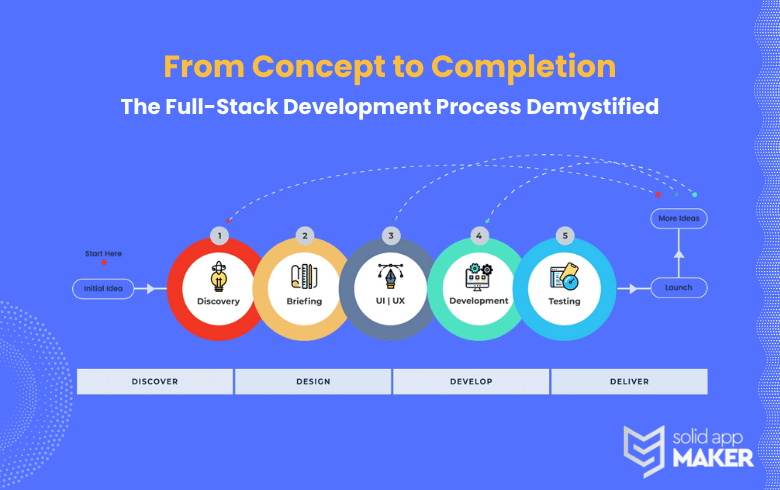In today’s rapidly evolving digital landscape, businesses rely heavily on web applications and software solutions to drive their success. Behind the scenes, a complex process known as full-stack development brings these ideas to life. Understanding the full-stack development process is crucial for businesses and individuals involved in web design and development.
In this blog post, we will unravel the path from concept to completion, offering valuable insights into the diverse stages encompassed within full-stack development. By the end, you’ll have a clear perspective on how ideas evolve and transform into fully realized web applications through the power of full-stack development.
Understanding the Full-Stack Development Process:
Full-stack development refers to the comprehensive approach of building web applications that encompass both front-end and back-end development. It involves the integration of multiple technologies, frameworks, and programming languages to create a seamless user experience. The front-end deals with the visual aspects of the application, while the back-end handles the server-side functionality and data management. Adopting a holistic approach allows developers to create dynamic, interactive, and robust web applications.
Phase 1: Requirement Gathering and Planning:
The first phase of the full-stack development process involves gathering requirements and planning the project. This stage is critical for setting clear goals, defining the target audience, and establishing the scope of the project. Extensive research and analysis are conducted to understand user needs, market trends, and competitors. Wireframes and prototypes are created to visualize the design and layout of the application, and project timelines are established to ensure efficient project management.
Phase 2: Front-End Development:
Once the requirements are finalized, the front-end development phase begins. This stage focuses on transforming design concepts into a functional user interface. Web developers use HTML, CSS, and JavaScript to build the visual elements of the application. They ensure that the design is responsive, providing a consistent experience across different devices and screen sizes. Interactive features, animations, and user-friendly interfaces are implemented to enhance the user experience and drive engagement.
Phase 3: Back-End Development:
Simultaneously, the back-end development phase takes place. This stage involves setting up the server infrastructure, creating databases, and implementing the logic that powers the application. Back-end developers work with programming languages such as Python, Ruby, or PHP, and frameworks like Node.js or Django. They handle data storage, server-side processing, and integration with external services and APIs. The goal is to ensure seamless communication between the front-end and back-end components of the application.
READ MORE: How Full-Stack Development Enhances Website Performance and Speed?
Phase 4: Testing and Quality Assurance:
Thorough testing and quality assurance are essential to ensure the reliability and performance of the application. Developers conduct rigorous testing to identify and fix any bugs or issues. They check for cross-browser compatibility, responsiveness, and overall functionality. Quality assurance professionals perform user testing, validating the application against the initial requirements and ensuring a smooth user experience. This phase helps to eliminate any potential risks and deliver a high-quality, error-free application.
Phase 5: Deployment and Launch:
With extensive testing complete, the application is ready for deployment and launch. This involves preparing the application for production, configuring servers, and setting up domain settings. Developers ensure that the application is secure, stable, and optimized for performance. They handle the migration of code and data from the development environment to the live server. Thorough checks are performed to confirm that all features and functionalities are working as intended.
Phase 6: Maintenance and Updates:
Once the application is live, the full-stack development process continues with ongoing maintenance and updates. Regular monitoring helps to identify any performance issues, security vulnerabilities, or necessary updates. Developers address any bugs or glitches that may arise and implement new features or enhancements based on user feedback. By ensuring continuous improvement and support, businesses can keep their application up-to-date, secure, and aligned with evolving user needs.
Final Takeaway:
The full-stack development process encompasses various stages, from requirement gathering to deployment and maintenance. By understanding the journey from concept to completion, businesses and individuals in the web design and development field can appreciate the complexity and effort involved in creating seamless web applications. Full-stack development allows for comprehensive solutions, combining front-end and back-end expertise to deliver exceptional user experiences.
By following a structured approach and leveraging the right technologies and frameworks, businesses can bring their ideas to life and stay ahead in the competitive digital landscape. Whether it’s creating e-commerce websites, interactive web applications, or complex software solutions, the full-stack development process plays a pivotal role in turning concepts into tangible, high-performing realities.
As you embark on your web development projects, partnering with a skilled and experienced full-stack development agency can greatly enhance your chances of success. Their expertise in handling both front-end and back-end aspects ensures a cohesive and optimized approach to your project. So, embrace the full-stack development process, and unlock the potential to create extraordinary digital experiences.
Remember, the full-stack development process is not just a linear journey but an iterative and continuous cycle of improvement. By embracing this holistic approach and staying abreast of emerging technologies and trends, businesses can harness the power of full-stack development to create innovative and impactful web solutions.
Stay tuned for more insights and tips on full-stack development as we delve deeper into specific aspects in our upcoming blog posts. Let’s unlock the potential of full-stack development together and create remarkable digital experiences for your audience.
Feel free to reach out to our North Carolina-based full-stack development agency if you have any questions or require assistance with your web development projects. We’re here to help you navigate the exciting world of full-stack development and drive your business towards success.

